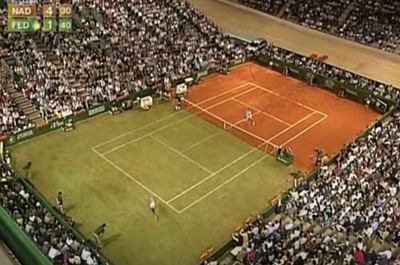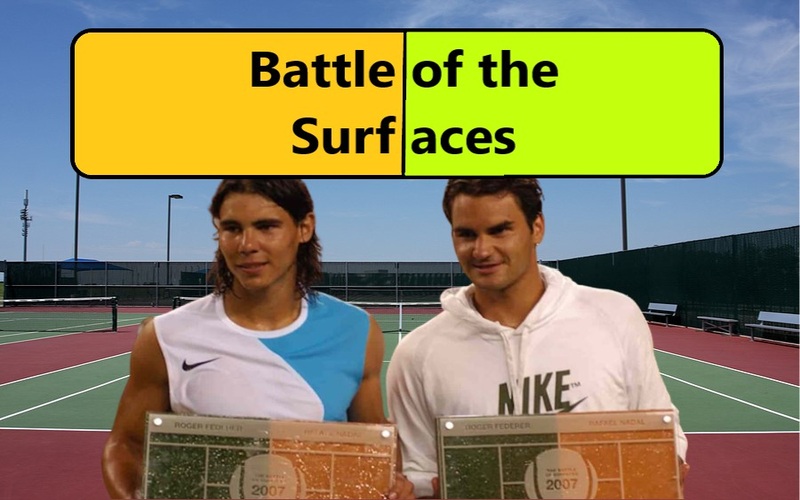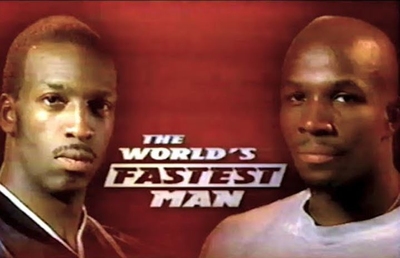On 2 May 2007, one of the most unique sporting events of all time took place between two of the world’s greatest tennis players: Rafael Nadal and Roger Federer.
This event was a three-set exhibition match played on a unique and rather bizarre court that had clay on one side of the net and grass on the other, which was dubbed the “Battle of Surfaces.”
In this article, we will be taking a look at why this unusual match took place, and which of the two tennis icons was victorious. We will then round up any similar events that have taken place within the world of sport.
Why Grass and Clay?
 Well, grass and clay were selected as the two components of the half and half court to reflect each player’s respective specialisations.
Well, grass and clay were selected as the two components of the half and half court to reflect each player’s respective specialisations.
Nadal, who has now won a record 14 French Open titles, and has never been defeated in finals at Roland Garros, is a master of clay, who had won some 72 consecutive matches on his favoured surface at the time.
Federer, on the other hand, was enjoying a hugely impressive 48-match winning streak on grass at the time, having not been defeated on the surface for five years, making this titanic clash extremely tough to call.
The Swiss was ranked number one in men’s singles at the time, whilst his Spanish opponent was number two, making this game effectively an attempt to figure out who was the undisputed best male tennis player on the planet.
Building the Court
To construct such a unique court was a tricky, and as you might expect, expensive challenge. Building the court reportedly cost over £1 million and took a period of 19 days to complete.
This court was located on Nadal’s home island of Majorca, in the capital’s Palma Arena, giving the Spaniard the advantage of a home crowd, as around 7,000 spectators turned up to watch the unusual match.
So, who was crowned victorious?
The Match

Prior to the multi-surface clash, Federer declared, “we are both looking forward to this absolutely new event… it ought to be interesting to see who chooses the better tactic.” Given that neither had defeated the other on their favourite surface, this was bound to be a close match, and it did not disappoint.
The first three games of the match went with serve, until Nadal managed to break his opponent in the fourth game, even though Federer was serving on to the grass half of the court. This left the Spaniard 3-1 up in the first set, and he was able to hold on, with the first finishing 7-5 to the clay champion.
In the second set, Federer immediately fought his way back into the match, breaking Nadal straight away to put himself 2-0 up. This put the Swiss master in control of the second set, which he ended up winning 6-4, leaving the two icons of the sport dead level heading into the third and final set.
In this all-important third set, Nadal was again able to break his opponent, and just like the first, secure a 3-1 lead. However, this time Federer was up for the challenge, and broke the Spaniard back, before holding his service game to make it 3-3. The contest remained level and went to a third set tie break, which Federer was able to quickly take control of, winning the first two points to make it 2-0.
However, the incredibly competitive Nadal was determined not to let his adoring home crowd down, and he fought back to level the game. The tie break then stayed level until the score reach 11-10 on serve, at which point Nadal managed to break the world number one to win it 12-10, securing easily the most unique crown of his career.
What Other Similar Sporting Events Have There Been?
Whilst Nadal and Federer’s clash was a unique concept, and not one that has been repeated since, there have been a number of other one-off sporting events that have similarly attempted to determine something outside of the “normal” rules of the sport.
Below, we will round up two of the most prominent examples.
The Battle of the Sexes

First up, we have another exhibition tennis match, the 1973 “Battle of the Sexes”, a game played between Billie Jean King, the women’s world number one at the time, and Bobby Riggs, a former men’s number one who was now 55 years old and retired.
Riggs believed that women’s tennis was inferior, and that he could take on and defeat any current women’s player. Four months prior to his match against King, Riggs had defeated Margaret Court in another exhibition event, winning the three-set game 6-2, 6-1, and this left King with a point to prove for women’s tennis.
In this game, the world number one was more than ready for Riggs, who had used drop shots and lobs to defeat Court, and she beat the 55-year-old by matching his defensive play style, sending him all over the court with ease.
The five-set match was won convincingly by King, who won 6-4, 6-3, 6-3, a landmark victory for women’s tennis, something King felt she had to legitimise by defeating the outspoken Riggs.
The Bailey-Johnson 150-Metre Race
 Another unique sporting event was the Bailey-Johnson 150-metre race, which was held in Toronto in 1997.
Another unique sporting event was the Bailey-Johnson 150-metre race, which was held in Toronto in 1997.
The race was contested by Olympic 100-metre champion Donovan Bailey and Michael Johnson, who had won gold in the 200 metres, to determine who was officially the “world’s fastest man.”
This was because some had argued that Johnson was quicker, as his Olympic-winning time of 19.32 seconds in the 200 metres was faster than Bailey’s 100 metre time of 9.84 seconds, when divided by two.
However, the Canadian Bailey won the race with ease, reaching the slightly curved portion of the 150-metre track ahead of his American opponent, who then proceeded to pull up at around 110 metres into the race, clutching his quads.
Bailey alleged that Johnson had pulled up purposefully, as he couldn’t handle being fairly beaten, but either way, the Canadian was crowned the world’s fastest man.
